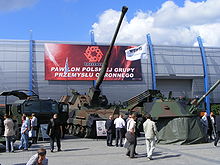- PT-91 Twardy
-
PT-91 "Twardy"
PT-91EXType Main battle tank Place of origin  Poland
PolandService history Used by  Poland
PolandSpecifications Weight 45.9 tonnes Length 6.95 m (9.67 with barrel in forward position)[1] Width 3.59 m[1] Height 2.19 m[1] Crew 3 Armor composite armour; front and side armor laminated; front, side and top armor behind Erawa-1/Erawa-2 ERA, steel side anti-cumulative screens Main
armament1 x 125mm 2A46M (D-81TM) gun (42 rounds)[1] Secondary
armament1 x 7.62mm PKT coaxial general purpose machine gun (2000 rounds)
1 x 12.7mm NSVT anti-aircraft heavy machine gun (300 rounds)[1]Engine PZL-Wola S-12U diesel
850 HP (634 kW)Power/weight 18.5 hp/tonne (13.8 kW/tonne) Transmission Manual Suspension torsion-bar Ground clearance 395 mm[1] Fuel capacity 1000 l[1] Operational
range650 km (700 km with extra fuel tanks)[2] Speed 60 km/h[1] PT-91M "Pendekar" 
PT-91M "Pendekar" of Malaysian Army on displayType Main battle tank Place of origin  Poland
PolandService history Used by  Malaysia
MalaysiaSpecifications Weight 48.5 tonnes [3] Length 6.86 m[3]
(10.03 m with barrel in forward position)[3]Width 3.70 m [3] Height 2.60 m [3] Crew 3[3] Armor composite armour; front and side armor laminated; front, side and top armor behind Erawa-1/Erawa-2 ERA, steel side anti-cumulative screens Main
armament1 x 125mm 2A46MS gun (40 rounds)[3] Secondary
armament1 x 7.62mm FN MAG coaxial general purpose machine gun (2000 rounds),
1 x 12.7mm FN M2 HB anti-aircraft heavy machine gun (250 rounds)[3]Engine PZL-Wola S-1000R diesel
1000 HP (735 kW)[3]Power/weight 16 kW/t Transmission Automatic Renk/SESM ESM-350M[3] Suspension torsion-bar Ground clearance 395 mm[3] Speed 65 km/h [3] - Lion of Babylon
- M-84
- M-84D
- M-95 Degman
- M-84AS
- PT-91 Twardy
- T-90
- Tank EX
- TR-125
Post-Cold War tanks- List
- Category
Under 120 mm gun
Not in service
- Altay
- Black Eagle
- EE-T1 Osório
- K2 Black Panther
- M60-2000
- M-95 Degman
- M-84AS
- T-95
- Tank EX
- Type 10
- Type 99KM
The PT-91 Twardy ("hard","tough" or "resilient") is a Polish main battle tank. It is a development of the T-72M1 and first entered service in 1995. The PT-91 was designed at the OBRUM (OBRUM for Ośrodek Badawczo-Rozwojowy Urządzeń Mechanicznych – Polish for Research and Development Centre for Mechanical Appliances) and is produced by the Bumar Łabędy company - part of Polish military consortium - Bumar Group. Changes from the T-72 include a new dual-axis stabilized fire-control system, reactive armour, a more powerful engine, transmission and new automatic loader. Unlike many other T-72 upgrades the Polish Army PT-91s are upgraded using elements created almost exclusively by domestic companies (this includes new engine, fire control system and all communication system elements). Many of those elements were used to upgrade existing fleets of T-72 tanks in countries like in Czech Republic - T-72M4Cz, Georgia - T-72SIM-1 or India - T-72 Ajeya Mk2.
Contents
History
In the late 1980s the Polish Army modernized all of its obsolete T-55 tanks to the T-55AM Mérida standard. The successful conversion convinced the General Staff that similar modernization could also be applied to other Soviet-designed tanks made in Poland and used by the Polish Armed Forces. In late 1988 it was decided to prepare a project of modernization for the T-72M1 design - using the experience from production of licenced T-72M (obiekt 172M-E3 - Polish army designation T-72), T-72M1 (obiekt 172M-E5), T-72M1K (Polish army designation T-72M1D).
The Gliwice-based Research and Development Centre of Mechanical Systems OBRUM (Polish: Ośrodek Badawczo-Rozwojowy Urządzeń Mechanicznych) was chosen as the main design bureau. However, initially the work progressed at a very slow pace, mainly because the Polish General Staff was also considering the purchase of a newer version of T-72 (T-72S) or the modern T-80.
After the political changes of 1989 and the dissolution of the Soviet bloc, Polish-Soviet talks on purchase of modern tanks came to a halt and the design of a new Polish tank gained momentum. The first design proposed by the bureau was code-named Wilk (Polish for wolf), but the project was cancelled. Instead, the priority was shifted to a different project named Twardy. The basic aim of the conversion of T-72 was to adapt it to the reality of modern warfare and fix its most visible deficiencies. Among those were low mobility, insufficient armour, lack of a fire control system and poor stabilisation of the main gun, which resulted in poor firing accuracy. An additional problem was lack of passive night vision aiming systems.
Development
Starting from July 1991 T-72 modernization programs were implemented by the Bumarcombine which had been producing T-72s under Soviet license. The modernized main battle tank was designated PT-91 Twardy. From base modification it differs in increased protection, fire control system and engine. In 1993 the Polish Defense Ministry ordered 20 PT-91 tanks to be used for field trials and Armed Forces tests.
The main battle tank's protection from high-explosive anti-tank (HEAT) projectiles and missiles is increased by the new Erawa dynamic armor developed by the Poland Military-Technical Institute. This protection consists of 394 tiles with explosives, detonating in case of a direct hit. The tiles cover 9m2 on the tank. 108 tiles are placed on the turret, 118 on the hull and 84 on each side's anti-HEAT screens. The Twardy uses steel anti-HEAT screens instead of the rubber used on the T-72. Erawa's main difference from the Soviet analogs is that Erawa's containers fit almost without gaps while on the Soviet modernised T-72 gaps reach 10 - 15 mm noticeably decreasing defense effectiveness. There are two Erawa modifications: Erawa-1 and -2, differing in weight of the explosives.
Experiments showed that the Erawa dynamic defense decreases the high-explosive jet impact depth by 50 - 70% and penetrator (APFSDS) projectiles by 30 - 40%. Furthermore, explosive containers don't detonate when hit by shot of up to 30 mm calibre, shell or mine fragments, or when covered in burning napalm or petrol.
The Twardy is armed with the same 125 mm smoothbore gun 2A46 used in the T-72, fitted with an automatic reloading mechanism which reduced the tank crew by one as it replaced the gun loader, and gave a rate of fire of 8 to 10 rounds per minute. Additional armament comprises the 7.62 mm PKT coaxial general purpose machine gun and 12.7 mm NSVT anti-aircraft heavy machine gun. The PT-91 has a thermosmoke device generating smoke screens from fuel and 24 grenade launchers fitted with smoke or anti-personnel frag grenades.
The modernization of the fire control system started by replacing the earlier used Soviet two plane stabilizer 2Є28M with a new stabilizer developed in Slovakia. It has an electronic information block showing the tank's technical condition. Furthermore it informs the commander when effective sighted fire becomes ineffective because of an excessively high cross-country speed or other reasons.
The Drawa fire control system, developed by Polish engineers, contains the gunner's day sight PCD and the TES thermovision night sight developed by the Israeli company ELOP, the commander's combined day-night passive observation and aiming sight POD-72, a ballistic computer, a laser rangefinder and a data system processing information for the ballistic computer. The sighting of the ballistic computer depends on the target's speed, weather conditions, projectile temperature and projectile type.
The driver uses the control and diagnostic complex US-DK-1 controlling the tank's main systems and displaying information on a monitor. The driver's night sight was replaced by the Radomka passive night sight.
The modernized tank's increased weight led the developers to add a more powerful engine. It is a 12 cylinder S-12U diesel engine, a modernized version of the Soviet V-46-6 produced in Warsaw by PZL-Wola (850 hp instead of 780). The main improvement is the modernized fuel and air injection system. This caused a noticeable decrease in the tank's road endurance. The latest Twardy variants have the 1000hp S-1000 engine with a turbocharger.
Variants
File:PT91 tank.jpgEarly production PT-91.PT-91 Twardy
Production variant for Polish Army, extensively modernized development of T-72M1. Most of the vehicles are equipped with SKO-1M Drawa-1T dual-axis stabilized fire control system (with TES - Thermal Elbow Sight - total number of delivered thermal sights is 202[4]) though some early production vehicles have a SKO-1 Drawa (with NV sight), Erawa reactive armour, a PCO SSC-1 Obra-1 laser-warning system and 850hp PZL-Wola S-12U engine. [5] The first 20 initial production vehicles were delivered to Polish Land Forces in 1993-1994 with another 78 full scale production vehicles delivered 1995-1997, 135 modernized T-72M1 tanks (made in late 80s) delivered 1998-2002. Both new and modernized tanks have the same combat capabilities.[5] Depending exact configuration Polish Army uses PT-91s in 3 variants PT-91, PT-91M and PT-91MA1 [6] (the M designation shouldn't be confused with the Malaysian variant).
PT-91A Twardy
Development variant with PZL-Wola S-1000 1,000-hp engine with mechanic transmission and number of other minor changes. Used for trials and as demonstrator on military exhibitions.
PT-91Z Hardy
(Z for Zmodernizowany – literally Modernized) Further development with SAGEM Savan-15 fire control system, according to life fire test Savan-15 has only minor advantage in accuracy over Drawa.[7] The biggest advantage was a new gun stabilization system that gave the tank a significant increase in accuracy when the tank is on the move. Later it was used as a base to develop the PT-91M. This variant has won a number of stress tests in Malaysia over T-90, T-84 and K1 tanks, and has won the competition for a new Malaysian MBT. Only one prototype was made.
PT-91M Pendekar
(M for Malaysia) — production export variant for Malaysia with SAGEM Savan-15 fire control system, PZL-Wola S-1000R 1,000-hp powerpack with Renk/SESM ESM-350M automatic transmission bringing its top speed to 70 km/h, and a new communications system. Weapons have been changed to a "Konštrukta defence a.s." design 2A46MS 125 mm tank gun made by ZTS - Špeciál a.s. , a 7.62 mm FN MAG coaxial machine gun and a 12.7 mm FN Browning M2 HB AA machine gun. This variant is also equipped with Sagem VIGY 15 gyro-stabilised panoramic sight optronics, a SIGMA 30 laser gyro inertial navigation system, EADS EPS72 turret stabilisation system, a PCO SSP-1 Obra-3 laser-warning system, communication systems: Thales TRC9310-3 F@stnet, Thales TRC3630-3, Thales SOTAS, ERAWA 3 Explosive Reactive Armour, ZM Dezamet 902A 81mm grenade launchers and Type 570P Diehl Remscheid GmbH tank tracks. Two prototypes made (renamed PT-91E and PT-91Ex), 48 serial PT-91M vehicles produced 2007 - 2009.[3][8]
PT-91E/Ex
(E for Export) - renamed prototypes of PT-91M used as demonstrators of export variant showed on military exhibitions. PT-91E is a first prototype named SP1 (it is same vehicle as shown on military parade in Kuala Lumpur in 2005), PT-91Ex is a second prototype named SP2. [3] Both vehicles faced number of tests in Malaysia SP1 was used for traction tests and has made 7000 km offroad in Malaysia, SP2 2000 km and 500 shoots from main cannon.[5] Very similar to PT-91M, offered for export to other countries.
PT-91P
(P for Peru) - Demonstrator for SITDEF Peru'2009 military exhibition. A cheaper alternative to PT-91Ex. This variant is equipped with newest PCO Drawa-TG fire control system with a thermal sight and modern communication system (Radmor RRC9310 radio, WB Electronics Fonet-IP communication system and Teldat battlefield management system). The vehicle was be shown on number of South American events including SITDEF Peru'2009 Expo.[9][10][11]
Related Vehicles
WZT-3
(WZT for Wóz Zabezpieczenia Technicznego – literally Technical Support Vehicle) – family of armoured recovery vehicles based on the PT-91/T-72 tank hull. Probably most popular T-72 based ARV on the world with over 400 vehicles delivered to the clients. It is armed with a 12.7 mm (½ in) machine-gun fitted to the commander’s hatch. Standard equipment includes: crane with telescopic jib that can lift a maximum load of fifteen tonnes, front-mounted stabilizing dozer blade, main and secondary winches.
- WZT-3 - A T-72 based variant for Polish Army - 20 vehicles.
- WZT-3M - A PT-91 based variant for Polish Army - 9 new vehicles and 20 WZT-3 upgraded to this standard.
- M-84AI - A M-84A based variant, made on licence in Yugoslavia - 15 vehicles for Kuwait
- ARV-3 - A T-72 based variant for Indian Army - 352 vehicles made
- WZT-4[12] - A PT-91M based variant for Malaysian Army (technically this vehicle is closely related to MID-M) - 6 vehicles
MID Bizon-S
(MID for Maszyna Inżynieryjno-Drogowa – lit. Engineering-Roading Machine; Bizon is Polish for Bison) – Polish engineering tank based on the PT-91 tank hull.
- MID - A PT-91 based variant for Polish Army - 8 vehicles
- MID-M - A PT-91M based variant for Malaysian Army - 3 vehicles
PMC
(PMC for Pomocniczy Most Czołgowy – lit. Auxiliary Tank Bridge) – Polish Armoured Vehicle Launched Bridge is a close support bridge layer. The PMC-90, developed on the basis of PT-91, is able to carry out missions required to operations of combat forces.
- PMC-90 - PT-91 based prototype vehicle with MLC-60 bridge. Not adopted.
- PMC-Leguan - PT-91M based variant for Malaysia equipped with the 26 m (87 ft) long MLC 60 Leguan bridge system. 5 vehicles for Malaysia.
- MG-20 Daglezja-G[13] (MG for Most Gąsienicowy – lit. Tracked Bridge) - a tracked bridge system, based on a lengthened T-72 chassis with one additional road wheel, equipped with a MLC-70 bridge system. Closely related to a truck based MS-20 Daglezja. Currently in development phase, it is expected to replace a T-55 based BLG-67M bridges in Polish Army.
PZA Loara
Main article: PZA Loara(PZA for Przeciwlotniczy Zestaw Artyleryjski – lit. AA Artillery System; “Loara” means “Loire (river)” in Polish) – antiaircraft artillery system is a Polish armoured radar directed Self Propelled Anti-Aircraft Gun system developed in the late 1990s. Based around the Twardy chassis, this system mounts an armoured turret holding two Oerlikon KDA 35 mm cannons linked to a radar fire control system. It was planned that it would work closely together with PZR “Loara” (anti-aircraft rocket system) vehicles built on the basis of the PZA Loara but that project is currently on hold. The Loara is an autonomous fire unit capable of performing its tasks independently or acting as a component of a wider air defense system. The system has two radars, 3D search radar and engagement radar. The search radar has a range of 26 km (16 mi) and is capable of tracking and identifying up to 64 targets at once. The radar system can also be operated on the move, refreshing its data every second. The system also has a laser range-finder, TV and FLIR cameras giving the system both all-weather day/night capabilities and the ability to operate entirely passively in a heavy ECM environment. The system also has a reaction time less than 10 seconds. The system can engage aircraft flying at altitudes from very low altitudes up to 5000 m (16,500 ft), and flying at speeds up to 500 m/s (1,125 mph). It is also effective against lightly armored ground and naval targets.
PT-94 Goryl
(Goryl is Polish for Gorilla) – project of a Polish main battle tank designed using experience gained on PT-91 project. The tank would be similar in its design to Merkava (engine at front), and it would feature redesigned engine, transmission and fire control system. Armor: composite + ERA, main armament: 120/125 mm gun, 60 mm mortar, secondary armament: 7.62 mm PKT coaxial machine gun, 12.7 mm NSWT AA machine gun, crew: 3. This program was also known under the name Anders. The program was cancelled at early stage.
PT-97 Gepard
(Gepard is Polish for Cheetah) sometimes known as PT-2001 – another modification project of a Polish main battle tank prepared as future modernisation programme for T-72 family, the programme was called for, as first PT-91 proposition fell below requirements. Two propositions were submitted, one by Bumar who provided a project with modified frontal armor, different mortar and sporting Leclerc - like turret with 2A46 main gun. OBRUM's competing project had new front and sides reactive armor and L-44 main gun.
Despite considerable improvements, neither was approved for financial reasons, and no prototypes were built, however design experience helped with new PT-91 versions.
Krab
Main article: AHS Krab(Krab is Polish for Crab) - 155 mm NATO-compatible howitzer designed by HSW S.A. combining OBRUMs UPG chassis, licensed AS-90M Braveheart turret with 52-calibre gun and WB Electronics Artillery Fire Control System Topaz. The Howitzer is equipped with S-12U engine and other elements (like road wheels) from PT-91.
Operators
 Poland
Poland233 PT-91s were delivered between 1995-2002 (232 vehicles remain in service) and 38 support vehicles based on the T-72/PT-91 hull (29 WZT-3M armoured recovery vehicle, 8 MID engineering tank and 1 prototype PZA Loara self-propelled anti-aircraft weapon).
Number of PT-91s delivered to Polish Land Forces each year[14] 1995-1996 1997 1998 1999 2000 2001 2002 58 58 7 33 50 20 7 Units equipped with PT-91 Twardy:
- 1 Warszawska Brygada Pancerna (1st Armored Brigade) – Warsaw district - Wesoła
- 2 Brygada Zmechanizowana Legionów (2nd Legions Mechanized Brigade) – Złocieniec[15]
- 34 Brygada Kawalerii Pancernej (34th Armored Cavalry Brigade) – Żagań
- Centrum Szkolenia Wojsk Lądowych (Land Forces Training Center) - Poznań[4]
Former units equipped with PT-91 Twardy:
- 10 Brygada Kawalerii Pancernej (10th Armored Cavalry Brigade) – Świętoszów (replaced with Leopard 2)
- 15 Wielkopolska Brygada Kawalerii Pancernej (15th Armored Cavalry Brigade) - Wędrzyn (unit disbanded)
- 17 Wielkopolska Brygada Zmechanizowana (17th Mechanized Brigade) - Międzyrzecz (replaced with KTO Rosomak)
At the introduction of PT-91 the intention of Polish General Staff was to equip all brigades of 11th Armored Cavalry Division with PT-91, at the time the division had 4 brigades: 10th Armored Cavalry, 15th Armored Cavalry, 17th Mechanized and 34th Armored Cavalry. In 2002, 10th Armored Cavalry received Leopard 2 A4 tanks donated to Poland by Germany, in 2007 the 15th Armored Cavalry was disbanded and the 17th Mechanized received the first KTO Rosomak. All these changes allowed the reallocation of PT-91s to other divisions, replacing the oldest T-72s.
A typical Polish PT-91 tank battalion equipped with 53 tanks is composed of 4 frontline companies with 13 vehicles in each and 1 tank for the battalion commander. Every company of 13 tanks is composed of three platoons with 4 tanks in each and 1 tank for the company commander.
 Malaysia
MalaysiaIn March 2002, Malaysia declared an intention to purchase tanks. In 2003 Polish enterprise wins an auction. Bumar Łabędy build 48 PT-91M and 15 support vehicles (6 WZT-4 {WZT-91M} armoured recovery vehicle, 3 MID-M {MID-91M} engineering tank, 5 PMC Leguan {PMC-91M} - armoured vehicle-launched bridge and one SJ-09 driver training tank), ammo, spares and support for $370 million USD.[3][8] The tanks were delivered to Malaysia in 2007-2009. Operational readiness since 1.9.2010.[16][17]
Number of PT-91M delivered to Malaysian Land Forces each year[18] 2005 2006 2007 2008 2009 SP1 prototype for trials SP2 prototype for trials 6 24 18 + 15 support vehicles Units equipped with PT-91M:
- Rejimen ke-11 Kor Armor DiRaja - (11th Regiment of Royal Armoured Corps) - Gemas
Rejimen ke-11 KAD is the sole user of PT-91M in Malaysian Army, PT-91M has replaced FV101 Scorpion light tank.
 India
IndiaIn April 1999, India ordered 44 WZT-3 armored recovery vehicles, which was followed by another two orders in April 2002 ( 80 vehicles), and in July 2005 (228 vehicles) – for a total of 352 WZT-3 armored recovery vehicles ordered. These vehicles are used to support the T-72 and T-90 MBT. [18] Deliveries began in 2001, and India is planning to upgrade its Ajeya Mk1 tanks (local name for T-72M1) to Ajeya Mk2 standard, with some elements from PT-91, such as the SKO-1T Drawa-T fire control system and the PZL-Wola S-1000 engine.[citation needed] In October 2011, Indian Defense Ministry announced that the state owned BEML will produce an additional 204 WZT-3 armored recovery vehicles - taking the total till 2011 to 556 vehicles.[19] The Ministry also clarified that no Global Tender was floated since it was a repeat order.
 Georgia
GeorgiaGeorgian army upgraded T-72SIM-1 tanks are using Drawa-T fire control system, a development of the fire control system on PT-91. The FCS is equipped with laser range finder and thermal imaging sensor. The system is slightly different from the one used on polish PT-91s, commander is using and LCD screen instead of the eyepiece (the gunner eyepiece is exactly same as on PT-91). The Thermal Elbow Sight thermal imaging sensor used in Georgian tanks is of the same (Israeli) origin as the one used on PT-91 but the external housing is different. [20]
References
- ^ a b c d e f g h "PT-91 on Modern Tanks"
- ^ "PT-91A on Modern Tanks"
- ^ a b c d e f g h i j k l m n o Nowa Technika Wojskowa - November 2007 page 15 - Pokaz "Malaja" i CV90120-T na Drawsku - by Andrzej Kliński
- ^ a b Nowa Technika Wojskowa - May 2008 page 22 - Odmłodzona Drawa - by Andrzej Kliński
- ^ a b c Nowa Technika Wojskowa - September 2007 page 14 - Jak można zmodernizować Twardego? - by Andrzej Kliński
- ^ Nowa Technika Wojskowa - September 2008 page 40 - Polskie wojska pancerne i zmechanizowane - meandry rozwoju - by Norbert Bączyk
- ^ Nowa Technika Wojskowa - November 1999 page 18 - Polskie T-72 - Co dalej? - by Tomasz Begier and Dariusz Użycki
- ^ a b Nowa Technika Wojskowa - October 2005 page 9 - Pierwsza prezentacja "Malaja" - by Andrzej Kliński
- ^ Nowa Technika Wojskowa - April 2009 page 16 - Twardy na wystawie w Peru - by Andrzej Kliński
- ^ Altair - PT-91P popłynął na SITDEF Peru 2009
- ^ "Peru army plans arms purchase, tests Chinese tanks". Associated Press. 2009-12-09. http://news.yahoo.com/s/ap/20091209/ap_on_re_la_am_ca/lt_peru_china_military.
- ^ Nowa Technika Wojskowa - September 2008 page 16 - "Wuzetka" dla Malzezji - by Andrzej Kliński
- ^ Nowa Technika Wojskowa - September 2008 page 26 - Most samochodowy MS-20 Daglezja - by Michał Sitarski
- ^ Nowa Technika Wojskowa - November 2004 page 20 - Polska w rejestrze uzbrojenia konwencjonalnego ONZ - by Jarosław Ciślak
- ^ Rp.pl. "Afera czołgowa w polskiej armii". rp.pl. http://www.rp.pl/artykul/441346_Afera_czolgowa_w_polskiej_armii.html. Retrieved 2011-11-14.
- ^ "Gotowość operacyjna PT-91M". Altair. http://www.altair.com.pl/start-5025. Retrieved 2011-11-14.
- ^ om een reactie te plaatsen! (2010-09-03). "Ulang Tahun Kor Armor Diraja ke 58". YouTube. http://www.youtube.com/watch?v=jbdR2EaNTYc&nofeather=True. Retrieved 2011-11-14.
- ^ a b Nowa Technika Wojskowa - February 2009 page 10 - Malaj na finiszu - by Andrzej Kliński
- ^ "More Armored Recovery Vehicles for Indian Army". Defense News. 2011-10-17. http://www.defensenews.com/story.php?i=7978427&&s=TOP. Retrieved 2011-11-14.
- ^ "Бронетехника в грузино-осетинском конфликте август 2008 - 0001.htm". Vadimvswar.narod.ru. http://vadimvswar.narod.ru/ALL_OUT/TiVOut0809/GruzPz08/GruzPz08001.htm. Retrieved 2011-11-14.
External links
- PT-91 on Bumar-Łabędy Web Site
- PT-91Ex on Bumar-Łabędy Web Site
- PT-91 Twardy Main Battle Tank at globalsecurity.org
- 3D tour of a Polish PT-91 tank (Java required}
Main battle tanks Light tanks Infantry fighting vehicles Armoured personnel carriers Armored cars MRAPs Cougar HFour-wheel drive vehicles Self-propelled guns Rocket artillery Self-propelled anti-aircraft guns Self-propelled surface-to-air missile systems Categories:- Main battle tanks of the post–Cold War period
- Main battle tanks of Poland
- Science and technology in Poland
- Tanks with autoloaders
Wikimedia Foundation. 2010.









